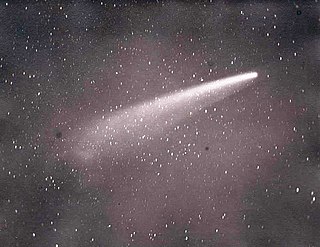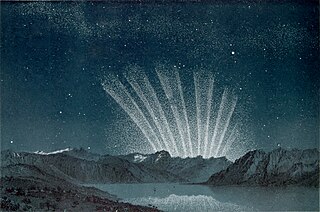
The Great Comet of 1811, formally designated C/1811 F1, is a comet that was visible to the naked eye for around 260 days, the longest recorded period of visibility until the appearance of Comet Hale–Bopp in 1997. In October 1811, at its brightest, and when it was 1.2 AU from Earth, it displayed an apparent magnitude of 0, with an easily visible coma.
Jérôme Eugène Coggia was a 19th-century French astronomer and discoverer of asteroids and comets, who was born in the Corsican town of Ajaccio.

Comet Donati, or Donati's Comet, formally designated C/1858 L1 and 1858 VI, is a long-period comet named after the Italian astronomer Giovanni Battista Donati who first observed it on June 2, 1858. After the Great Comet of 1811, it was the most brilliant comet that appeared in the 19th century. It was also the first comet to be photographed.

The Great Comet of 1882 formally designated C/1882 R1, 1882 II, and 1882b, was a comet which became very bright in September 1882. It was a member of the Kreutz Sungrazers, a family of comets which pass within 1 R☉ of the Sun's photosphere at perihelion. The comet was bright enough to be visible next to the Sun in the daytime sky at its perihelion. The comet made its closest approach to Earth on 16 September 1882 at 0.99 AU and then came to perihelion the next day on 17 September.

The Great Comet of 1861, formally designated C/1861 J1 and 1861 II, is a long-period comet that was visible to the naked eye for approximately 3 months. It was categorized as a great comet—one of the eight greatest comets of the 19th century.
The Comet of 1729, also known as C/1729 P1 or Comet Sarabat, was an assumed parabolic comet with an absolute magnitude of −3, the brightest ever observed for a comet; it is therefore considered to be potentially the largest comet ever seen. With an assumed eccentricity of 1, it is unknown if this comet will return in a hundred thousand years or be ejected from the Solar System.

23P/Brorsen–Metcalf is a periodic comet with an orbital period of 70 years. It fits the classical definition of a Halley-type comet with. It was first discovered by Theodor Brorsen at the Altona Observatory on July 20, 1847, and again by Kaspar Schweizer (Moscow) on August 11, 1847. It was predicted that it would reappear between 1919 and 1922.
Comet Crommelin, also known as Comet Pons-Coggia-Winnecke-Forbes, is a periodic comet with an orbital period of almost 28 years. It fits the classical definition of a Halley-type comet with. It is named after the British astronomer Andrew C. D. Crommelin who calculated its orbit in 1930. It is one of only four comets not named after their discoverer(s), the other three being Comets Halley, Encke, and Lexell. It next comes to perihelion around May 27, 2039 when it will be near a maximum near-perihelion distance from Earth.

The Great Comet of 1744, whose official designation is C/1743 X1, and which is also known as Comet de Chéseaux or Comet Klinkenberg-Chéseaux, was a spectacular comet that was observed during 1743 and 1744. It was discovered independently in late November 1743 by Jan de Munck, in the second week of December by Dirk Klinkenberg, and, four days later, by Jean-Philippe de Chéseaux. It became visible with the naked eye for several months in 1744 and displayed dramatic and unusual effects in the sky. Its absolute magnitude – or intrinsic brightness – of 0.5 was the sixth highest in recorded history. Its apparent magnitude may have reached as high as −7, leading it to be classified as a Great Comet. This comet is noted especially for developing a 'fan' of six tails after reaching its perihelion.

C/2002 T7 (LINEAR) is a non-periodic comet discovered in 2002 by LINEAR project. The comet brightened to a magnitude of 2.2.
X/1872 X1, occasionally referred to as "Pogson's Comet", was a probable cometary astronomical object seen from Madras on December 3 and 4, 1872, by astronomer N. R. Pogson.

The Great Southern Comet of 1887, or C/1887 B1 using its International Astronomical Union (IAU) designation, was a bright comet seen from the Southern Hemisphere during January 1887. Later calculations indicated it to be part of the Kreutz Sungrazing group. It came to perihelion on 11 January 1877 at a distance of 0.00483 AU (723 thousand km) with a velocity of 606.1 km/s. Since the Sun has a radius of 696000 km, the comet passed about 27000 km from the surface of the Sun.

The Great Comet of 1901, sometimes known as Comet Viscara, formally designated C/1901 G1, was a comet which became bright in the spring of 1901. Visible exclusively from the southern hemisphere, it was discovered on the morning of April 12, 1901 as a naked-eye object of second magnitude with a short tail. On the day of perihelion passage, the comet's head was reported as deep yellowish in color, trailing a 10-degree tail. It was last seen by the naked eye on May 23.

C/2011 L4 (PanSTARRS), also known as Comet PANSTARRS, is a non-periodic comet discovered in June 2011 that became visible to the naked eye when it was near perihelion in March 2013. It was discovered using the Pan-STARRS telescope located near the summit of Haleakalā, on the island of Maui in Hawaii. Comet C/2011 L4 probably took millions of years to come from the Oort cloud. After leaving the planetary region of the Solar System, the post-perihelion orbital period is estimated to be roughly 107000 years. Dust and gas production suggests the comet nucleus is roughly 1 kilometer (0.62 mi) in diameter, while based on the absolute nuclear magnitude and a geometric albedo of 0.04 the diameter of the nucleus is over 2.4 kilometers (1.5 mi). A method based on coma magnitude decay function estimated the effective radius at 2.317 ± 0.190 km.

C/1807 R1, also known as the Great Comet of 1807, is a long-period comet. It was visible to naked-eye observers in the northern hemisphere from early September 1807 to late December, and is ranked among the great comets due to its exceptional brightness.

C/1769 P1 (Messier) is a long-period comet that was visible to the naked eye at its last apparition in 1769. The comet is classified as a great comet due to its superlative brightness.
C/1865 B1 was a non-periodic comet, which in 1865 was so bright that it was visible to unaided-eye observations in the Southern Hemisphere. The comet could not be seen from the Northern Hemisphere.

The Great Comet of 1819, officially designated as C/1819 N1, also known as Comet Tralles, was an exceptionally bright and easily visible comet, approaching an apparent magnitude of 1–2, discovered July 1, 1819 by the German astronomer Johann Georg Tralles in Berlin. It was the first comet analyzed using polarimetry, by French mathematician François Arago.

C/1963 A1 (Ikeya), also known as Comet 1963I and 1963a, is a long period comet discovered by Kaoru Ikeya on 2 January 1963. The comet last passed perihelion on 21 March 1963, when it reached an apparent magnitude of 2.8.
C/1989 W1 (Aarseth–Brewington) is a non-periodic comet discovered on 16 November 1989 independently by Knut Aarseth and Howard Brewington. It reached an apparent magnitude of 2.8.
















